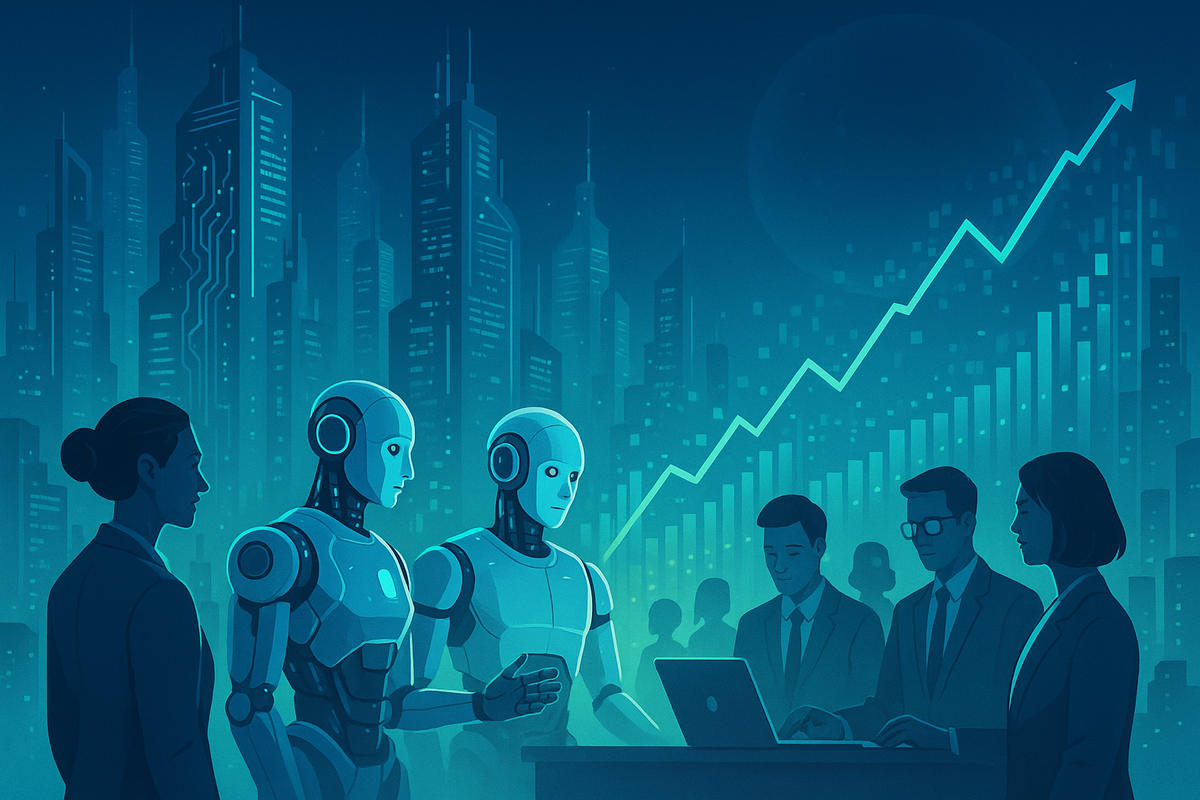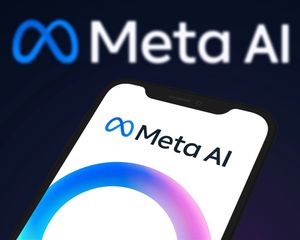
The global economy is currently in the throes of an unprecedented AI boom, a technological revolution characterized by rapid advancements, massive investments, and widespread adoption of artificial intelligence across industries. This surge, often dubbed an "AI spring," is not merely a fleeting trend but a fundamental reshaping of economic landscapes and technological paradigms. While promising significant productivity gains and contributing substantially to GDP growth, this fervent activity has also ignited a heated debate about a potential "AI bubble," drawing parallels to past speculative market frenzies.
The immediate implications are profound, with AI poised to boost labor productivity, transform job markets, and drive economic expansion. However, the concentration of capital in a few dominant players, coupled with concerns about overvaluation and the long-term sustainability of current growth trajectories, casts a shadow of uncertainty over the future of this transformative technology.
The AI Tsunami: What Happened and Why It Matters
The current AI boom is a confluence of several critical factors, culminating in an explosive period of innovation and investment. At its core, the rapid evolution of generative AI technologies, particularly large language models, has captured global attention and imagination. This has led to an unprecedented influx of capital, with AI investments more than doubling to over $100 billion in 2024, now accounting for a staggering 37% of the global venture capital market. In the U.S. alone, private AI investment reached $109.1 billion in 2024, with generative AI attracting $33.9 billion globally, an 18.7% increase from the previous year.
This surge is not just about financial speculation; it's driven by tangible advancements. AI is becoming more efficient, affordable, and accessible, with the inference cost for systems performing at the level of GPT-3.5 plummeting over 280-fold between November 2022 and October 2024. Hardware costs have also seen a significant decline, dropping by 30% annually. This increased accessibility has fueled widespread adoption, with 78% of organizations reporting AI usage in 2024, a substantial jump from 55% the year prior. Executives are increasingly prioritizing AI, with 83% ranking it as their top strategic imperative.
However, this rapid expansion is not without its complexities. A significant concern is the increasing concentration of capital. While overall investment is high, it's increasingly flowing into fewer, larger companies. Tech giants like Meta (NASDAQ: META), Amazon (NASDAQ: AMZN), Microsoft (NASDAQ: MSFT), and Alphabet (NASDAQ: GOOGL) are making colossal strategic investments in AI infrastructure, such as data centers and GPUs. This massive capital expenditure, while driving growth, is also straining the free cash flow of these companies, raising questions about the long-term financial returns of these investments. This trend also makes it significantly harder for smaller AI startups to secure early-stage financing, potentially leading to an oligopolization of the AI market.
The debate around an "AI bubble" is intensifying, with market analysts drawing parallels to the dot-com era. Soaring valuations, particularly for early-stage AI companies, and the sheer volume of capital inflows are raising concerns about the sustainability of current growth trajectories. The industry is transitioning from a "build it" phase to a "prove it" phase, demanding clear demonstrations of productivity and revenue impacts. While the stock market has seen significant gains, largely attributed to AI investments, a potential correction could impact investor portfolios, though the impact on the "real economy" might be less severe than on the stock market itself. Governments worldwide are also stepping up their involvement, with increased AI-related regulations and significant investments, indicating a growing recognition of AI's strategic importance and the need for governance.
The AI Gold Rush: Winners and Those at Risk
The AI boom is creating a clear delineation between the companies poised for unprecedented growth and those facing significant disruption or even obsolescence. The winners are predominantly those deeply entrenched in AI infrastructure, research, and the seamless integration of AI into their core products and services.
At the forefront of the winners' circle is Nvidia (NASDAQ: NVDA), which has achieved a near-monopoly in the Graphics Processing Unit (GPU) market. These powerful chips are the foundational hardware for training and running complex AI models, making Nvidia an indispensable "enabler" of the AI revolution. The company's market capitalization has soared, even reaching $4 trillion, as demand for its chips continues to outstrip supply. Its business model, centered on providing this critical infrastructure, has positioned it as a dominant force.
Other major tech players are also reaping substantial rewards. Microsoft (NASDAQ: MSFT) has strategically invested in OpenAI, integrating generative AI technologies like ChatGPT and DALL-E into its Bing search engine, Edge browser, Office suite, and Azure cloud platform. Its Azure cloud computing platform is experiencing rapid growth, driven by the burgeoning demand for AI application development, allowing Microsoft to offer comprehensive AI services to a vast enterprise customer base. Similarly, Alphabet (NASDAQ: GOOGL), through its DeepMind and Google Brain divisions, remains a pioneer in AI research, with breakthroughs like AlphaFold. Google Cloud offers a comprehensive suite of generative AI tools through its Gemini ecosystem, enabling businesses to leverage AI for various applications, enhancing user experience and data analysis across its services. Amazon (NASDAQ: AMZN), with its leading Amazon Web Services (AWS) cloud computing platform, is exceptionally well-positioned, introducing its own Nova models and deeply integrating advanced AI across its cloud infrastructure and business operations. Companies like Oracle (NYSE: ORCL) and Palantir Technologies (NYSE: PLTR) are also demonstrating strong performance by effectively leveraging AI to enhance their offerings. Even IBM (NYSE: IBM) has seen significant growth in its software segment due to strategic AI investments and has become a leader in AI-related patents.
Conversely, the AI boom poses significant challenges to companies whose traditional business models are susceptible to automation, disruption by generative AI, or those slow to adapt. Traditional software companies like Salesforce (NYSE: CRM), Adobe (NASDAQ: ADBE), ServiceNow (NYSE: NOW), Asana (NYSE: ASAN), HubSpot (NYSE: HUBS), and SAP SE (NYSE: SAP) are facing immediate threats. Investors are reconsidering their positions due to fears that AI could replace or automate many of the digital services they provide, leading to declines in their stock prices and market value. The concern is that AI may "consume a portion of the software sector itself." The stock imagery industry, exemplified by Getty Images (NYSE: GETY), is also under severe disruption as generative AI can create images and videos rapidly and cheaply, challenging traditional licensing revenue models.
Consulting firms like Accenture (NYSE: ACN) are seeing their traditional business model of deploying large teams of human analysts and coders threatened, as generative AI can now produce code, analyze datasets, draft reports, and offer strategic recommendations, automating many routine tasks. This pressures billable hours and profit margins, forcing firms to pivot towards becoming AI enablers. Customer service providers, such as Teleperformance (EPA: TEP), which rely on large pools of human agents, are directly threatened by AI-driven chatbots and voice assistants. Staffing agencies like ManpowerGroup (NYSE: MAN) also face challenges as AI systems can screen resumes, match candidates, and perform many tasks traditionally handled by human workers. IT services companies like Infosys (NSE: INFY), TCS (NSE: TCS), and Wipro (NSE: WIPRO) are experiencing reduced demand for traditional programming and testing services, necessitating a fundamental shift in their business models. Ultimately, any business model heavily dependent on human labor or specialized creative skills that generative AI can replicate faster and cheaper faces an existential disruption risk.
The AI Tsunami: Industry Impact and Broader Implications
The AI boom is not merely a technological shift; it's a seismic event reshaping entire industries, contributing significantly to global GDP growth, fueling intense debates about market sustainability, and prompting governments worldwide to grapple with the complexities of regulation, particularly concerning AI-generated content.
The contribution of AI to GDP growth is already substantial and growing. Research indicates that AI-related investments contributed a significant 0.5 percentage point difference to annualized GDP growth in the United States during the first half of 2025. Without this aggressive spending by tech giants like Amazon (NASDAQ: AMZN), Google (NASDAQ: GOOGL), Microsoft (NASDAQ: MSFT), and Apple (NASDAQ: AAPL)—projected to exceed $400 billion on AI infrastructure in 2024 alone—the US economy would have grown at less than 1%. Some estimates suggest that AI's contribution to US real GDP growth could be as high as 40% when considering investments in computer and communications equipment, data centers, grid upgrades, and the intellectual property value of software. Globally, generative AI alone could add an equivalent of $2.6 trillion to $4.4 trillion annually across 63 use cases, potentially increasing the impact of all AI by 15% to 40%. Industries such as banking, high tech, and life sciences are expected to see the most significant impact, with the International Monetary Fund (IMF) suggesting AI could affect nearly 40% of jobs worldwide and increase global GDP by $7 trillion (or 7%) over 10 years. However, some economists, like MIT's Daron Acemoglu, offer more conservative estimates, projecting a more modest GDP boost, arguing that adoption hurdles might slow the transformative effects.
The debate around an "AI bubble" is intensifying, with many drawing parallels to the dot-com era. Arguments for a bubble include soaring valuations, particularly for AI startups, with 64% of all US venture capital in the first half of 2025 allocated to AI, totaling $118 billion. This capital is highly concentrated, with just eight companies, including OpenAI, xAI, and Anthropic, raising 62% of the total AI funding for 2025. Companies like OpenAI have seen their valuations skyrocket to $300 billion despite not yet being profitable. Furthermore, a new MIT study from 2025 revealed that 95% of enterprise AI pilot programs fail to deliver measurable financial returns, highlighting a significant gap between investor optimism and practical enterprise reality. The massive infrastructure overbuilding, with leading AI companies investing hundreds of billions in new data centers, also mirrors the dot-com era's over-optimistic deployment of fiber optic networks. The market concentration, with the "Magnificent Seven" tech stocks making up over a third of the S&P 500, further heightens risk. Even OpenAI CEO Sam Altman has warned that the market may be overheating. However, counterarguments emphasize genuine AI adoption, the profitability of key players like Microsoft and Nvidia, and the enormous long-term potential of AI, suggesting a "bubble of expectations" rather than a full-blown collapse.
The rapid proliferation of AI-generated content has also spurred governments worldwide to consider and implement regulations, with China taking a leading role. China's "Measures for the Labelling of Artificial Intelligence-Generated and Synthetic Content," set to take effect on September 1, 2025, impose both explicit and implicit labeling obligations on various entities involved in AI content generation and propagation. Explicit labels are visible indicators (e.g., text, icons, audio cues) that clearly inform users when content is AI-generated, especially for content that could cause confusion or misunderstanding. Implicit labels are embedded in the metadata, including production information and creator details. These regulations cover all types of AI-generated content, and obligations apply to service providers, internet information content propagation service providers (e.g., social media platforms), app distribution platforms, and even users. Non-compliance can result in penalties, including service suspension. Globally, the regulatory landscape is fragmented. The European Union (EU) AI Act, approved by member states, aims to create risk-based rules for AI development and use, with its AI Office developing standards for transparency of AI-generated content by the end of the year. In the United States, while the federal government has pivoted towards deregulation, many states are passing their own AI laws, creating a fractured regulatory environment. For example, Colorado passed a comprehensive AI law in May 2024, requiring developers and deployers of high-risk AI systems to exercise reasonable care to prevent algorithmic discrimination. This evolving regulatory landscape highlights the complex challenge of balancing consumer protection and societal well-being with the promotion of innovation and creativity in the age of AI.
What Comes Next: Navigating the AI Frontier
The trajectory of the AI boom in the coming months and years will be defined by a complex interplay of continued technological advancement, market dynamics, and evolving regulatory frameworks. In the short term, we can expect to see a relentless pursuit of tangible value and a clear return on investment (ROI) from AI initiatives. This will foster a more discerning investment environment, where capital flows towards solutions with clear business cases rather than mere hype. Enhanced business automation will continue to be a key driver, with generative AI handling routine customer interactions, basic employee queries, and accelerating decision-making through instant, data-driven insights. The demand for high-density data centers, memory chips (HBM), advanced packaging, and even electricity supply will intensify, creating both bottlenecks and significant opportunities for infrastructure providers. However, the rapid adoption of AI and automation could also lead to short-term job displacement in certain sectors, necessitating careful policy management and workforce retraining.
Looking further ahead, the long-term possibilities are transformative. AI is projected to contribute significantly to global GDP, with some estimates suggesting a $15.7 trillion boost by 2030 and the AI market growing twentyfold to nearly $2 trillion by the same year. Agentic AI and embodied AI are expected to be key drivers of efficiency and new revenue streams, permeating every aspect of business from supply chains and marketing to analysis. The development of artificial general intelligence (AGI), with companies like Meta (NASDAQ: META) aiming for it by 2027, could lead to unprecedented changes where AI extends human capabilities with far-reaching consequences. Societally, AI could revolutionize healthcare through advanced diagnostics and new treatments, enhance patient care, and assist with human care and household tasks, boosting productivity and efficiency across various settings.
Strategic pivots will be crucial for businesses to remain competitive. This includes significant investment in attracting and retaining AI talent, research, and ethical AI development. Companies will need to adopt agile strategies and decision-making processes, leveraging real-time AI-powered insights to make rapid adjustments in response to market shifts or changing customer preferences. For startups, a clear, well-defined AI strategy, focusing on niche markets with unmet needs, will be essential for differentiation in a crowded market. Furthermore, building flexibility into business models, fostering a culture of change and experimentation, and re-engineering infrastructure with modular, AI-optimized designs will be paramount for navigating the rapid, AI-driven changes.
Market opportunities abound, particularly in AI infrastructure, with companies providing GPUs (Nvidia (NASDAQ: NVDA)), cloud computing services (Microsoft Azure (NASDAQ: MSFT), Amazon AWS (NASDAQ: AMZN), Google Cloud (NASDAQ: GOOGL)), and equipment for AI chip production (ASML (AMS: ASML)) being clear beneficiaries. Opportunities also exist for companies developing specialized AI applications for specific industry needs or offering services to help businesses navigate AI adoption complexities. However, significant challenges remain, including the ongoing "AI bubble" concerns, the pressure to demonstrate clear ROI from massive AI investments, and ethical and societal concerns such as bias, job displacement, and the environmental impact of AI. The regulatory landscape will continue to evolve, with governments grappling with establishing clear frameworks for responsible AI development and deployment. The future could see a soft landing and consolidation, a significant downturn or "AI winter," incremental adoption and productivity gains, or even transformative change leading to a "compressed century" of innovation. The key will be careful planning, strategic investment, and a deep understanding of both the immense opportunities and the formidable challenges that lie ahead.
Conclusion: A New Era of Innovation and Uncertainty
The AI boom represents a pivotal moment in economic and technological history, ushering in an era of unprecedented innovation and profound societal transformation. Its contribution to GDP growth is undeniable, driven by massive investments in infrastructure and the promise of enhanced productivity across virtually every sector. However, this rapid ascent is accompanied by a palpable sense of uncertainty, fueled by the ongoing debate surrounding an "AI bubble" and the complex ethical and regulatory challenges that arise from the widespread deployment of intelligent systems.
Moving forward, the market will likely demand greater accountability and demonstrable value from AI initiatives. The initial speculative fervor may give way to a more pragmatic approach, where companies that can translate AI capabilities into tangible business outcomes and sustainable revenue streams will thrive. Investors should closely monitor not only the technological advancements but also the financial health and strategic pivots of key players, particularly the "Magnificent Seven" tech giants, whose substantial AI investments are currently propping up economic growth. The concentration of capital in these few entities, while driving innovation, also presents a systemic risk that warrants careful observation.
The regulatory landscape, particularly in China, is setting precedents for how AI-generated content will be governed, emphasizing transparency and accountability. This trend is likely to spread globally, with governments striving to balance innovation with consumer protection and the mitigation of risks such as misinformation and bias. The long-term impact of AI on the job market, global inequality, and environmental sustainability will depend heavily on the policy decisions made today. Ultimately, the AI revolution is a double-edged sword, offering immense potential for progress while simultaneously posing significant challenges that require thoughtful navigation. The coming months will be critical in determining whether the current boom evolves into a sustainable period of growth or succumbs to the pressures of overvaluation and unfulfilled promises. Investors, policymakers, and the public alike must remain vigilant, adapting to a rapidly changing world where artificial intelligence is no longer a futuristic concept but a present-day reality with far-reaching implications.






